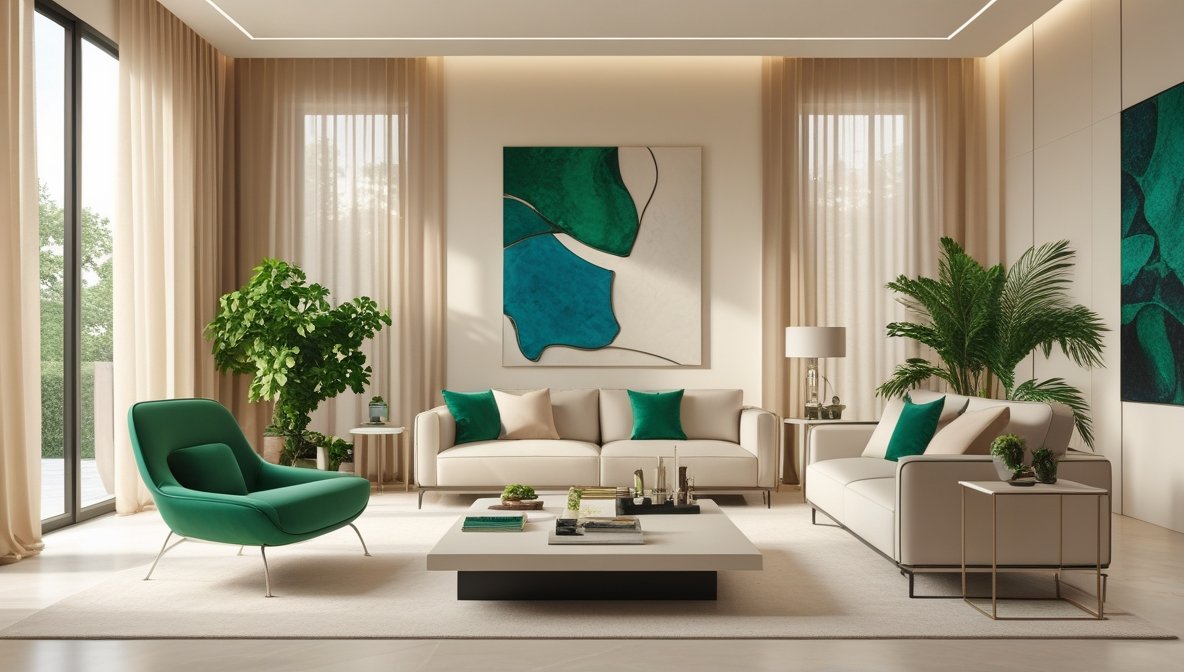The new year always brings fresh possibilities, and 2025 is no exception when it comes to transforming our living spaces. As we settle into this post-pandemic era of mindful living, our homes have evolved from mere shelters into sanctuaries that reflect our values, support our well-being, and adapt to our ever-changing lifestyles.
This year’s interior design trends tell a fascinating story of contrast and harmony. We’re seeing bold maximalism dance alongside serene minimalism, while cutting-edge technology seamlessly blends with handcrafted authenticity. It’s as if designers worldwide have collectively decided that our spaces should be both statement-making and soul-soothing, innovative yet timeless.
What makes 2025’s trends particularly exciting is their emphasis on personalization and sustainability. Gone are the days of cookie-cutter, Instagram-perfect rooms that feel more like showrooms than homes. Instead, we’re embracing designs that celebrate individuality, champion eco-consciousness, and create genuine emotional connections with our surroundings.
Whether you’re planning a complete home makeover or simply looking to refresh a single room, these 15 trending styles will inspire you to create spaces that truly feel like you.
Interior Design Trends for 2025
1. Luxurious Texture Play with Bold Accent Colors
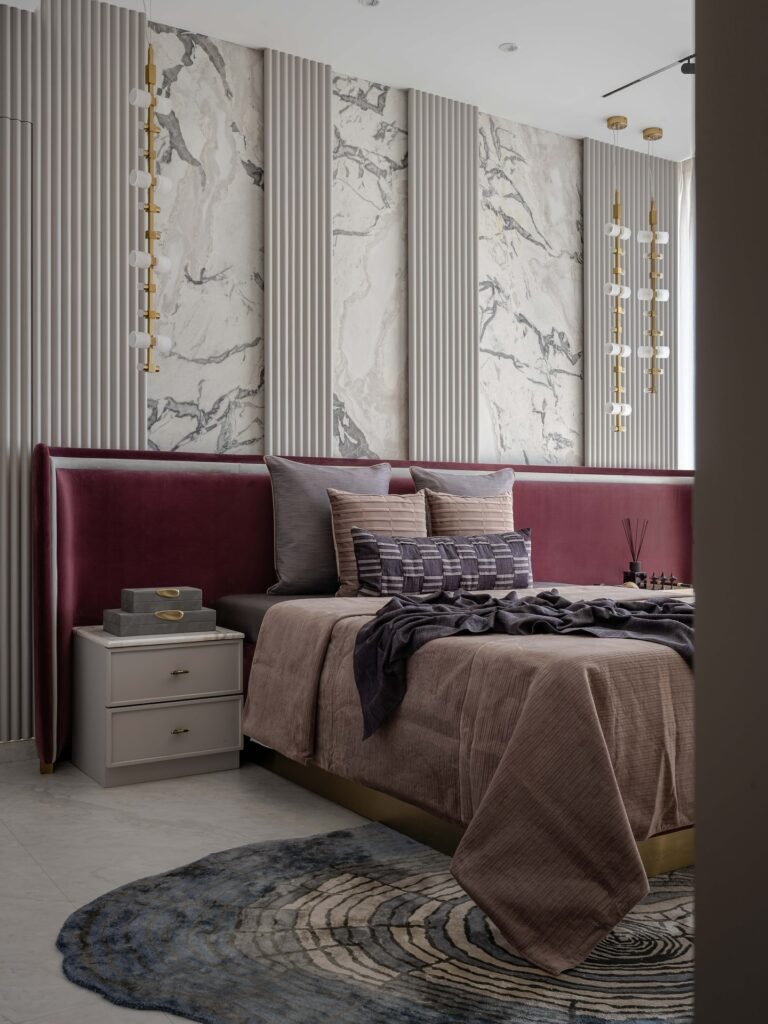
pathosbyfaizhira
This sophisticated bedroom showcases the growing trend of rich burgundy and wine tones making a comeback in 2025.
The deep red upholstered headboard creates a dramatic focal point against the neutral palette, while the fluted wall panels add architectural interest and texture. The marble accent wall brings natural luxury into the space, perfectly balanced by the geometric area rug that grounds the room with its organic patterns.
The layered bedding in coordinating earth tones demonstrates how designers are embracing tactile comfort alongside visual appeal. The brass pendant lighting adds warmth and elegance, while the carefully curated accessories create a hotel-like luxury that feels both opulent and livable.
2. Serene Minimalism with Natural Elements
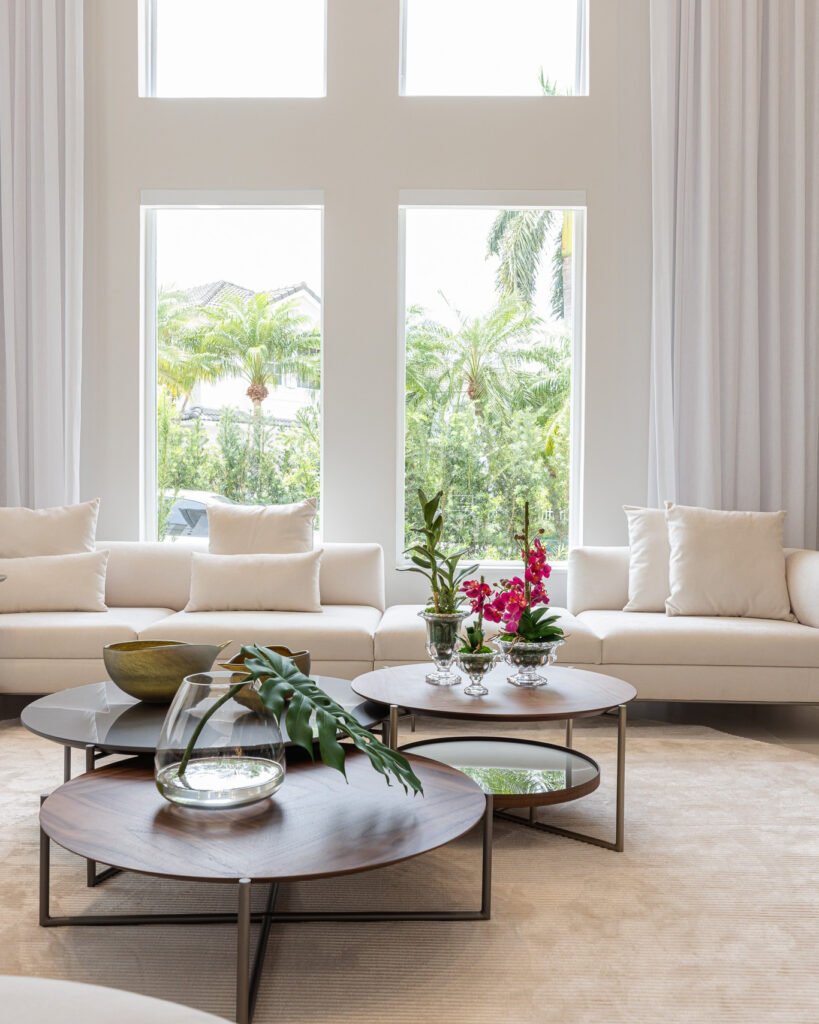
This living space epitomizes the “quiet luxury” trend that’s dominating 2025 interiors. The neutral color palette of creams and soft whites creates a calming atmosphere, while the oversized windows blur the boundaries between indoor and outdoor living. The modular seating arrangement speaks to our need for flexible, adaptable furniture that can accommodate different lifestyle needs.
The layered circular coffee tables add visual interest without cluttering the space, and the tropical greenery visible through the windows reinforces the biophilic design trend. This room proves that minimalism doesn’t have to feel stark – instead, it can be warm, inviting, and deeply connected to nature.
3. Moody Sophistication with Abstract Art
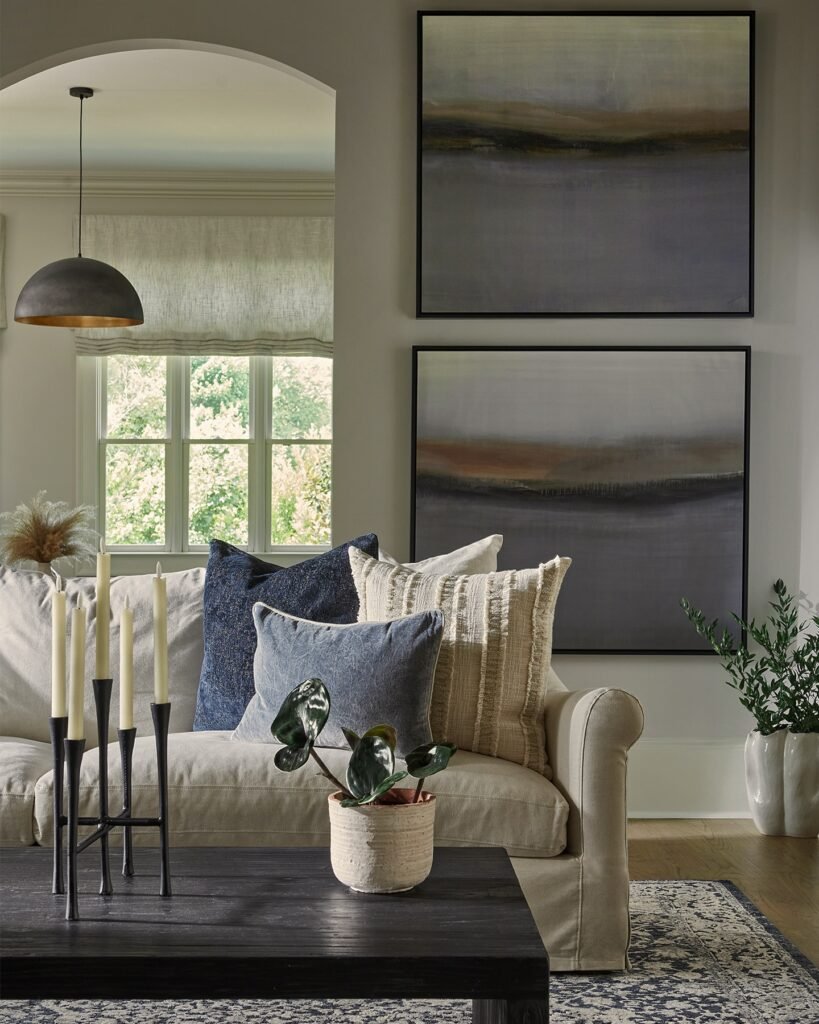
This living room demonstrates the power of large-scale abstract artwork in creating focal points and adding emotional depth to neutral spaces. The oversized landscape paintings bring a sense of contemplation and artistic sophistication, while the varied pillow textures add layers of visual and tactile interest. The warm beige and gray palette creates a cocoon-like feeling of security and comfort.
The mix of materials – from the woven textures to the smooth surfaces – shows how 2025 design is all about creating sensory experiences. The black dome pendant light adds a touch of industrial chic, proving that even the most serene spaces can benefit from unexpected design elements.
4. Integrated Technology and Seamless Design

This contemporary living room showcases how technology integration has become seamlessly sophisticated in 2025. The built-in entertainment wall combines marble-look panels with clean lines, hiding all the technical components while maintaining aesthetic appeal. The modular seating system speaks to our desire for furniture that adapts to our changing needs and social situations.
The architectural ceiling treatment with integrated lighting demonstrates how functional elements can become design features. The neutral palette allows the clean lines and geometric forms to take center stage, while the single plant adds life and warmth to the space without disrupting the minimalist aesthetic.
5. Textural Walls and Curved Furniture
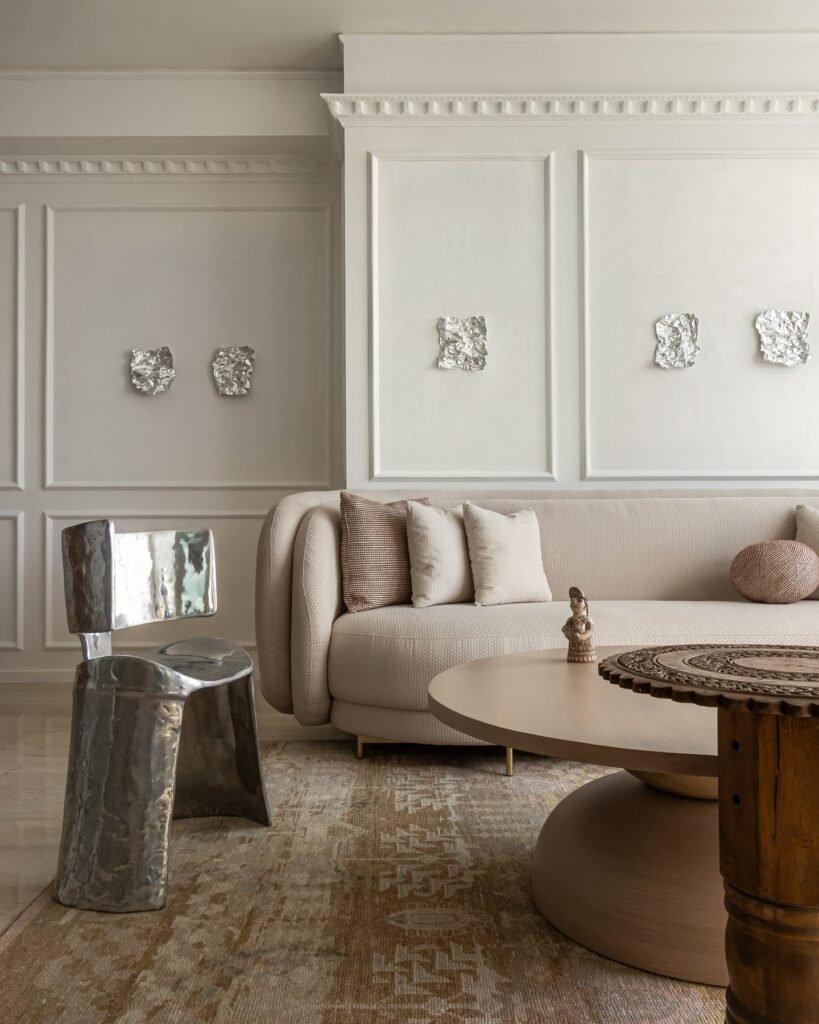
This refined living space highlights the resurgence of decorative wall treatments and curved furniture silhouettes. The classic wainscoting and crown molding provide timeless architectural detail, while the metallic sculptural elements add contemporary artistic flair.
The curved sofa represents the move away from sharp angles toward more organic, embracing forms that invite relaxation.
The neutral palette allows the architectural details and sculptural elements to shine, proving that traditional elements can feel fresh and modern when executed with contemporary sensibilities.
6. Organic Shapes and Integrated Lighting
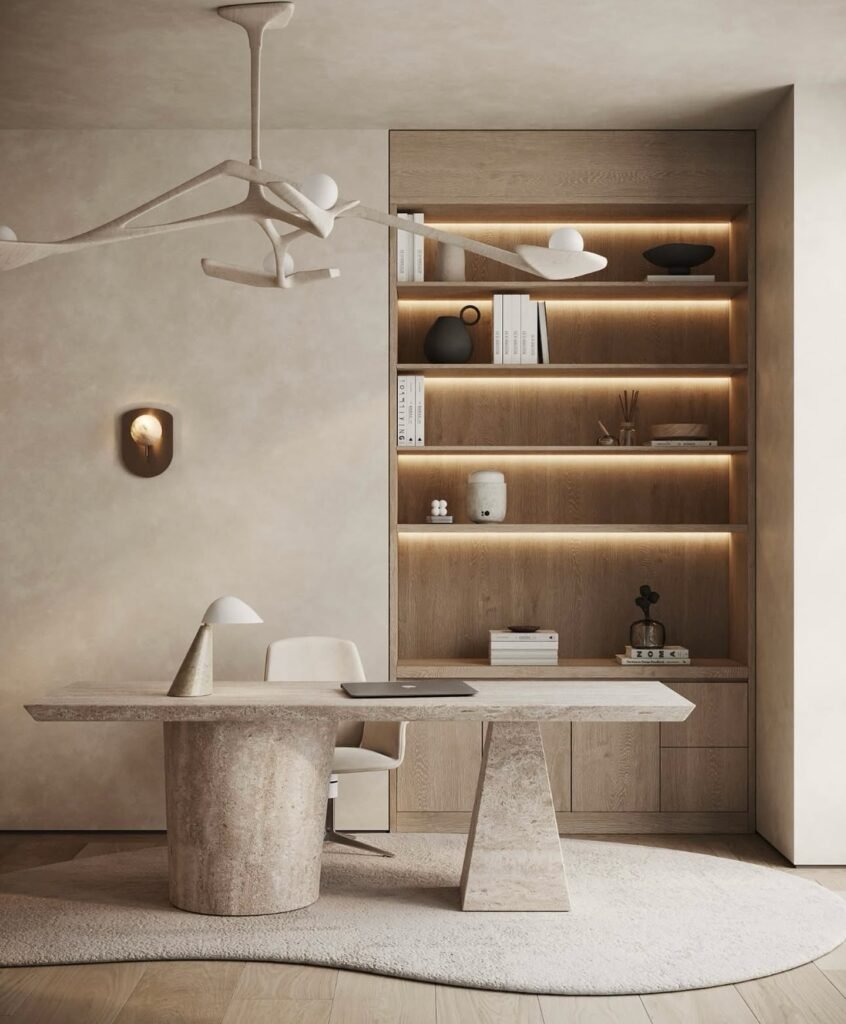
This office space exemplifies the trend toward biomorphic design and integrated lighting solutions. The sculptural ceiling fixture resembles organic forms, bringing an artistic element to functional lighting.
The built-in shelving with LED strip lighting showcases how storage can become a design feature rather than an afterthought.
The natural stone desk and curved forms throughout the space create a sense of harmony with nature, even in a work environment.
This design proves that home offices can be both highly functional and aesthetically striking, supporting productivity while nourishing the soul.
7. Retro Revival with Sculptural Elements
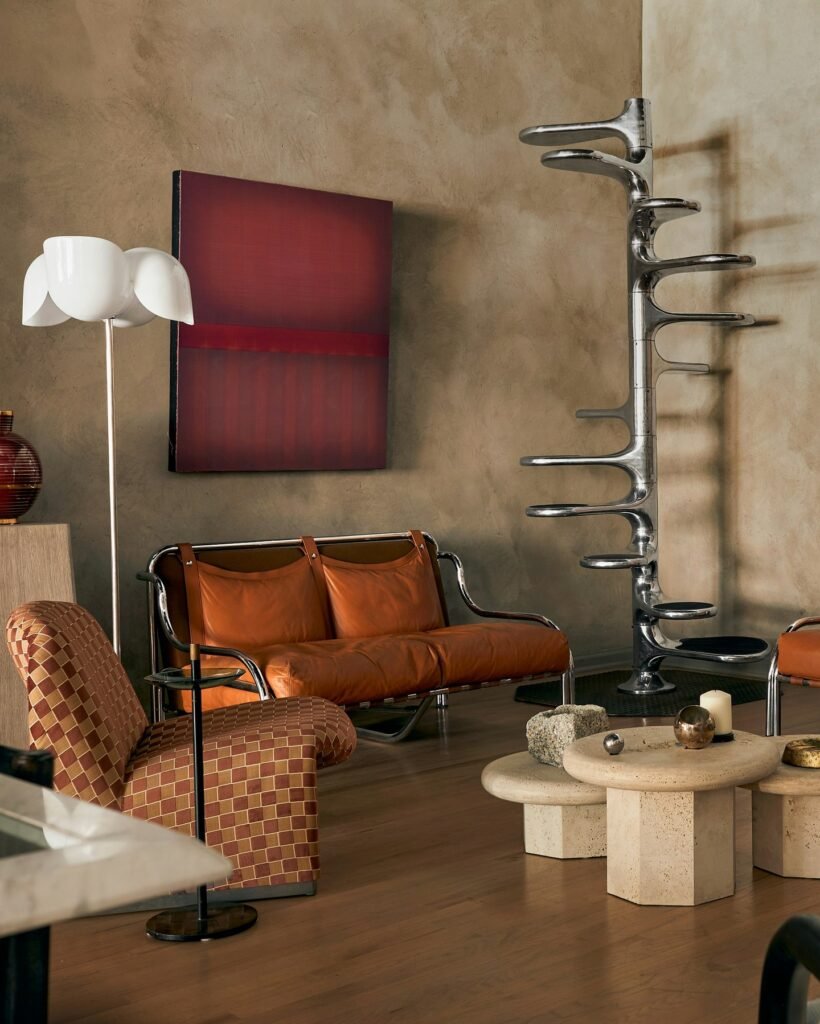
This striking room captures the 70s revival trend that’s gaining momentum in 2025. The orange leather seating and geometric patterns on the armchair bring bold color and retro flair, while the sculptural chrome bookshelf serves as both storage and art piece. The rich burgundy artwork adds depth and sophistication to the warm color palette.
The travertine-style coffee table and organic shapes throughout the room demonstrate how retro trends are being updated with contemporary materials and forms.
This space shows that maximalist design can still feel curated and intentional when executed with confidence and artistic vision.
8. Classic Elegance with Modern Functionality
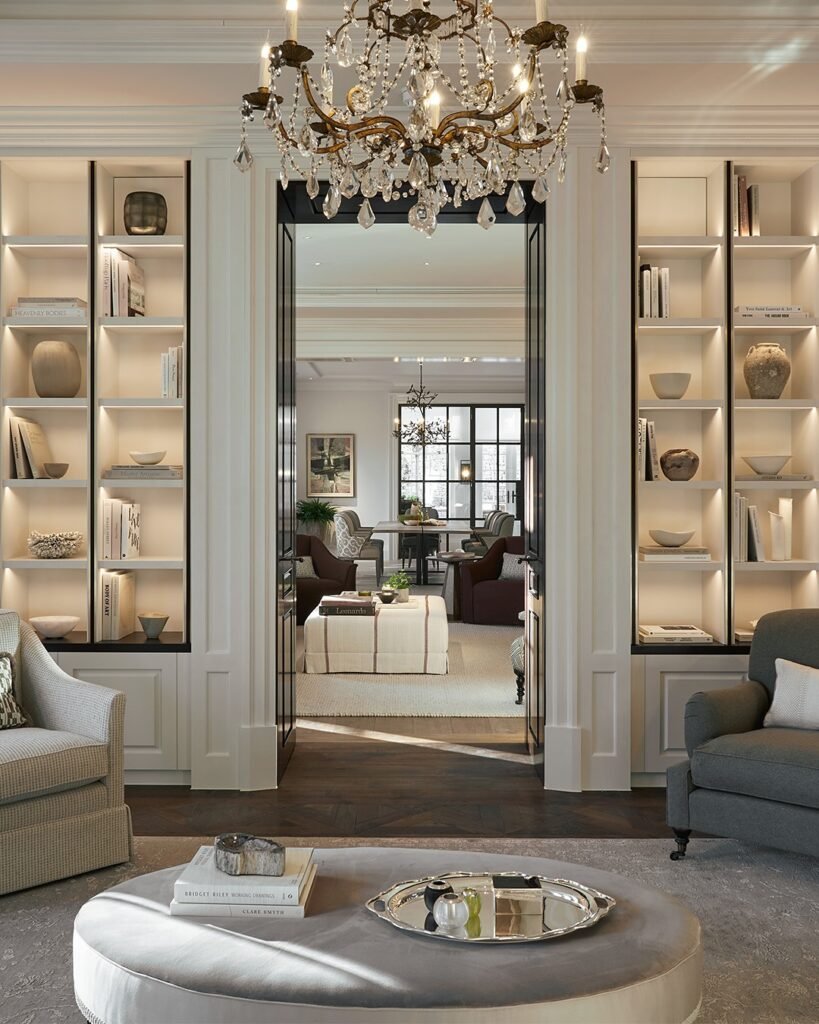
This traditional living room proves that classic design elements remain timelessly appealing in 2025.
The crystal chandelier and built-in bookcases with integrated lighting create a sense of grandeur and sophistication, while the neutral palette keeps the space feeling fresh and current. The floor-to-ceiling storage solutions show how traditional millwork can serve modern organizational needs.
The layered lighting approach—from the statement chandelier to the subtle shelf lighting—demonstrates how classic spaces can incorporate contemporary lighting technology. The sightlines through to adjacent rooms create a sense of flow and openness that speaks to modern living preferences.
9. Traditional Charm with Contemporary Flow
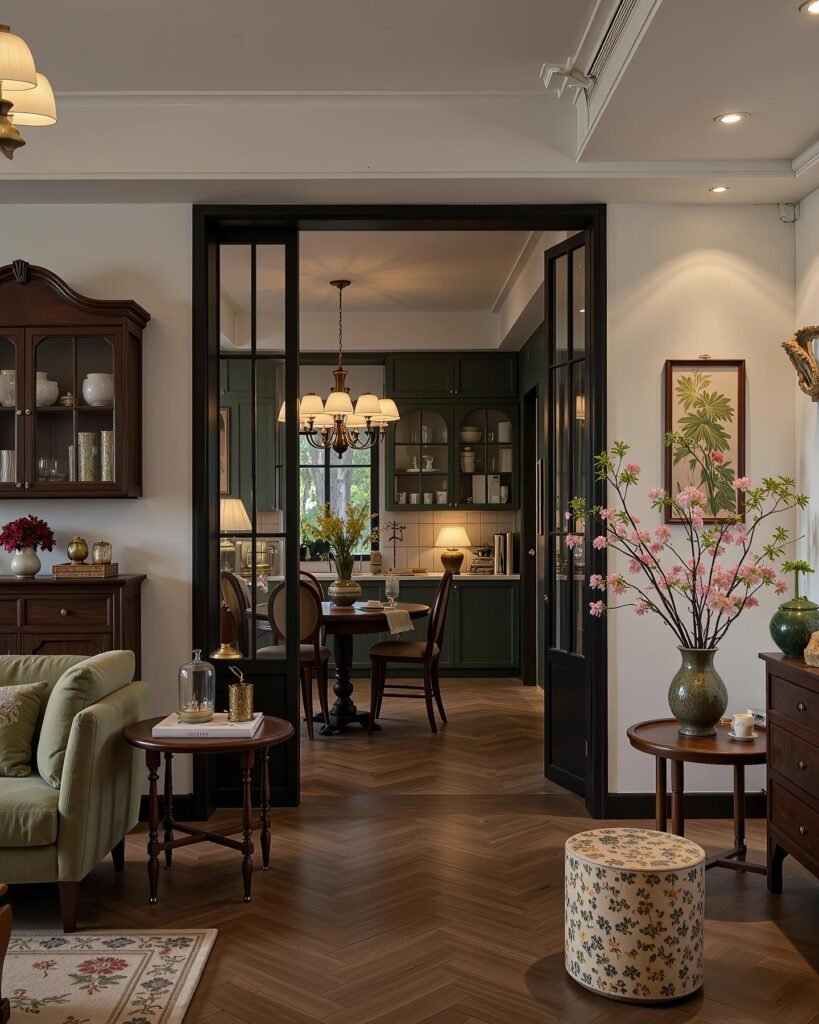
This space beautifully illustrates the trend toward “grandmillennial” design – a fresh take on traditional aesthetics. The rich wood tones and classic furniture pieces create warmth and character, while the black steel and glass room dividers add contemporary architectural interest.
The deep green kitchen visible in the background shows how bold colors are being used in unexpected ways.
The herringbone wood floors and carefully curated accessories demonstrate attention to detail and craftsmanship.
10. Moody Maximalism: The Dark Academia Home Office Revolution
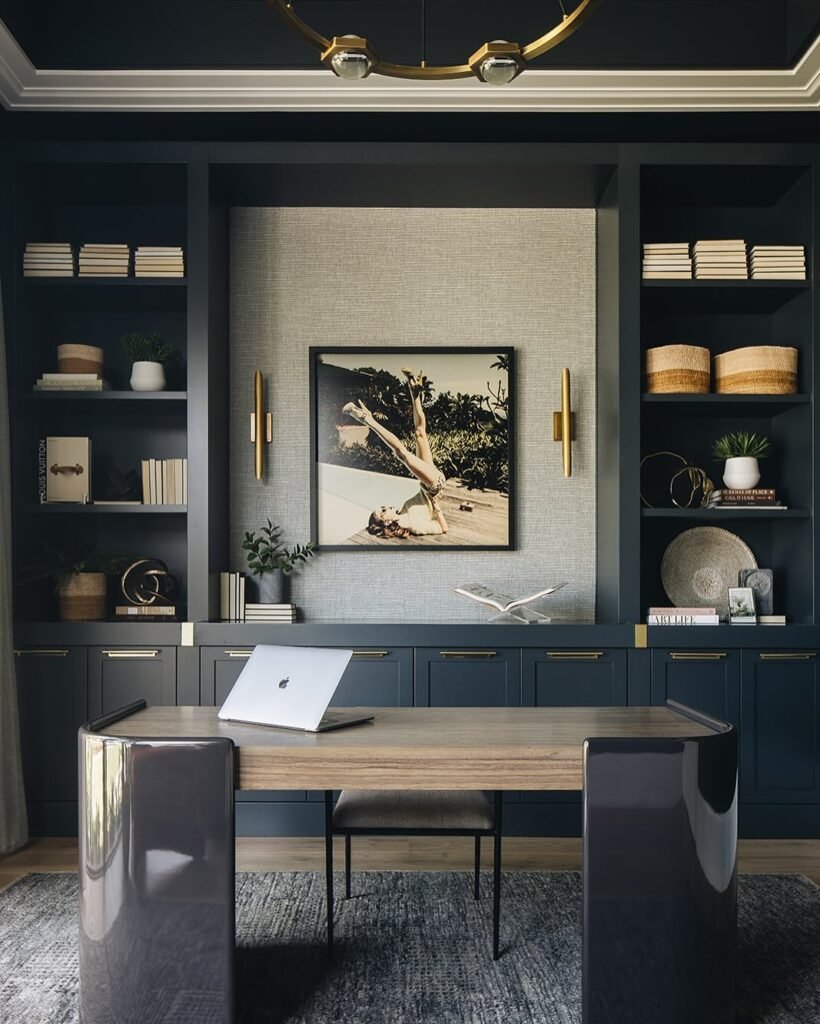
This sophisticated home office exemplifies the growing trend of dark, dramatic interiors that prioritize both function and luxury. The deep navy built-in cabinetry creates a cocoon-like atmosphere, while brass hardware and lighting fixtures add warmth and elegance.
The grasscloth wallpaper backdrop provides texture and visual interest, perfectly framing the large-scale photography that serves as the room’s focal point. Natural elements like woven baskets and small plants soften the masculine palette, while the sculptural desk with its curved chrome base represents the current fascination with statement furniture pieces.
This design demonstrates how home offices are evolving from purely functional spaces into sophisticated sanctuaries that reflect personal style.
11. Sculptural Statements
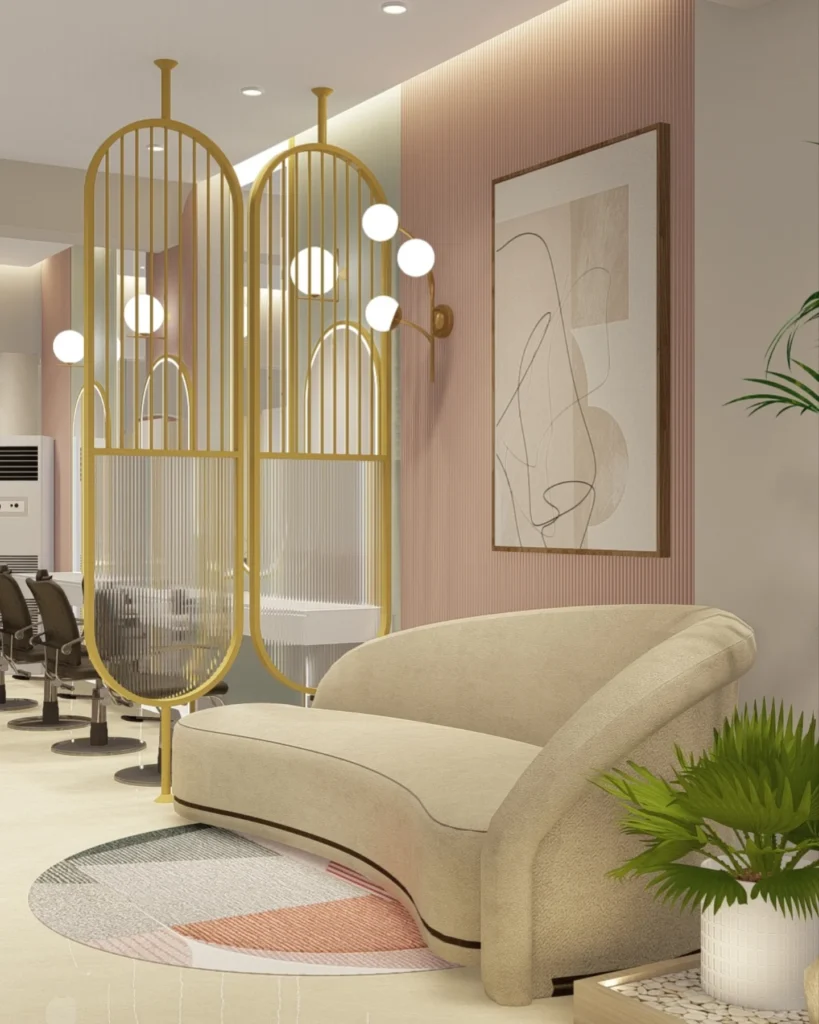
This contemporary living space showcases the rising trend of architectural room dividers and sculptural furniture that doubles as functional art. The striking gold-toned oval screens create visual separation while maintaining an open, airy feel—a perfect solution for modern open-plan living.
The curved, organic sofa in neutral linen speaks to the current movement away from rigid, angular furniture toward softer, more inviting forms. The warm coral accent wall with vertical fluting adds texture and depth, while the abstract line drawing continues the theme of artistic elements integrated into everyday living spaces.
This design perfectly captures the trend of creating Instagram-worthy moments within functional interiors.
12. Timeless Grandeur: Classic Elegance Meets Modern Luxury
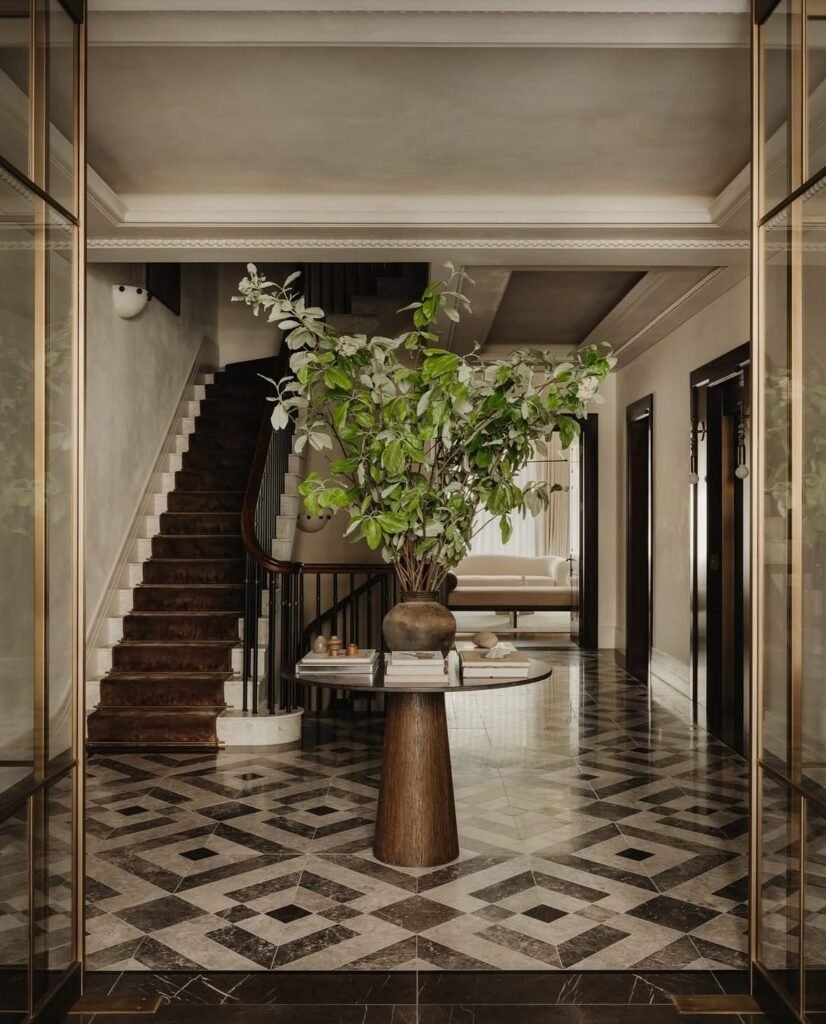
This stunning entryway represents the enduring appeal of traditional design elements executed with contemporary sophistication. The geometric marble flooring in rich browns and creams creates a dramatic foundation, while the brass-framed glass partitions add transparency without sacrificing elegance.
The curved staircase with its classic balustrade demonstrates how traditional architectural details can feel fresh and relevant in modern contexts.
The oversized organic sculpture serves as a striking centerpiece, proving that contemporary art can enhance rather than compete with classical elements. This space exemplifies the trend of “quiet luxury”—where quality materials and expert craftsmanship speak louder than flashy displays.
13. Rustic Refined: The New Country Chic
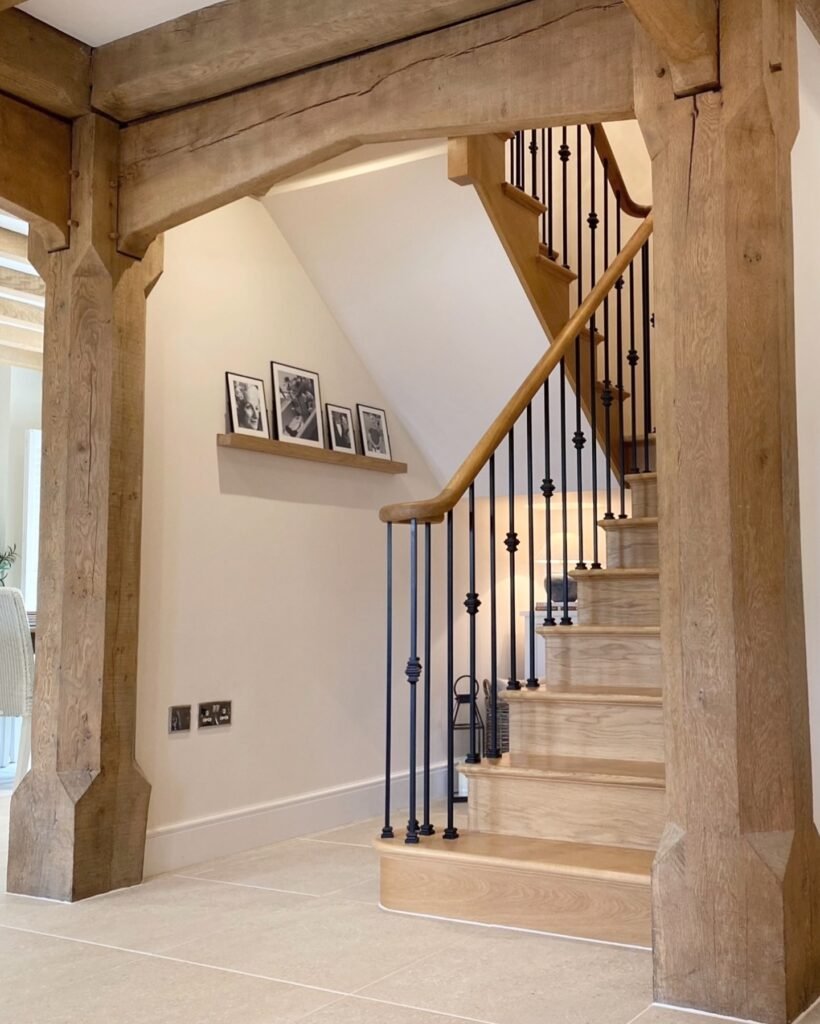
This staircase design perfectly captures the evolution of rustic style from farmhouse kitsch to sophisticated country elegance. The substantial oak timber framing and exposed joinery celebrate traditional craftsmanship while feeling entirely contemporary.
The combination of natural wood with crisp white walls creates a perfect balance between warmth and freshness. The wrought iron spindles add delicate detail without overwhelming the clean lines, while the floating picture ledge provides a modern display solution.
This approach to rustic design shows how natural materials and traditional techniques can create spaces that feel both rooted in history and completely current.
14. Architectural Drama: The Power of Built-In Design

This elegant built-in unit showcases the growing trend of custom millwork that maximizes both storage and style. The arched alcove creates architectural interest and draws the eye upward, making the ceiling feel higher and the space more grand.
The sage green paint color reflects the current fascination with muted, sophisticated hues that create calm, cocoon-like environments. Brass hardware and the statement sconce add luxury touches, while the carefully curated styling demonstrates the art of “shelfie” composition. This design proves that storage solutions can be beautiful focal points rather than hidden necessities.
15. Warm Minimalism: The Kitchen That Whispers Luxury

This kitchen design exemplifies the shift toward warmer, more tactile minimalism that prioritizes natural materials and subtle texture. The two-toned cabinetry—combining cream upper cabinets with rich wood-grain lowers—creates visual interest while maintaining clean lines.
The diamond-pattern backsplash adds geometric intrigue without overwhelming the serene palette, while brass hardware and fixtures provide the perfect amount of glamour. The marble countertops with their subtle veining and the floating wood shelves introduce organic elements that soften the contemporary aesthetic.
This space demonstrates how modern kitchens are becoming more living room-like, with an emphasis on comfort and beauty alongside functionality.
Conclusion
As we’ve explored through these stunning interior spaces, today’s design landscape is defined by a beautiful paradox: the marriage of timeless elegance with contemporary innovation. From the moody sophistication of dark academia offices to the warm embrace of refined rustic elements, these trends share a common thread—the celebration of craftsmanship, natural materials, and thoughtful curation over fleeting fashion.
The spaces we’ve examined demonstrate that luxury today isn’t about excess, but about intention. Whether it’s the sculptural furniture that doubles as art, the architectural drama of custom millwork, or the serene beauty of warm minimalism, each trend speaks to our desire for homes that nurture both body and soul.

